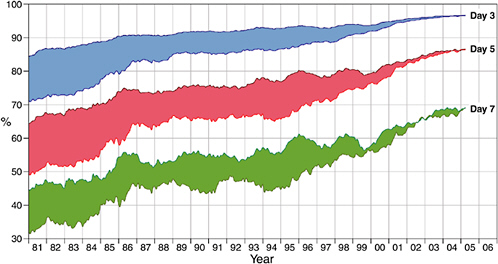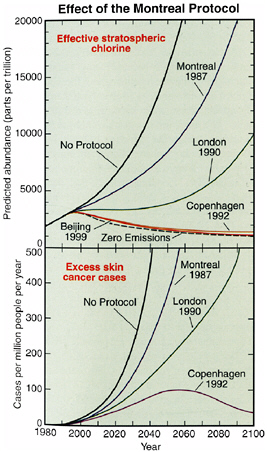1
Science for the Benefit of Society
The Earth’s well-being is also an issue important to America. And it’s an issue that should be important to every nation in every part of our world.
—President George W. Bush discussing climate change on June 11, 20011
Progress in Earth science over the last two decades has been dramatic, a consequence of decisions made in the 1980s to study Earth as a system.2 Research in Earth system science has led to remarkable insights and new lines of inquiry based on how Earth’s atmosphere, oceans, and land interact and evolve as a whole to sustain life. How Earth will continue to change in the future and what these changes will mean to society are scientific questions of profound importance.
Improved scientific understanding of Earth also forms the foundation for practical applications that enhance the prosperity and security of society. Businesses, government agencies, and even individuals rely on products and services that have emerged from Earth science research programs. For example, improvements in the ability to forecast weather (Box 1.1) have had an enormous impact on society. Today’s 4-day weather forecast is as accurate as 2-day forecasts were 20 years ago.3 The error in the 3-day forecast landfall position of hurricanes has been reduced from about 210 miles in 1985 to about 110 miles in 2004.4 Sea surface winds and precipitation can be observed at accuracies that allow emergency managers to more efficiently evacuate coastal residents in the path of hurricanes. As a result, lives are saved and property losses are minimized. Increased knowledge about the ocean-atmosphere-land system suggests
|
1 |
See <http://www.whitehouse.gov/news/releases/2001/06/20010611-2.html>. |
|
2 |
For example, the report that led to NASA’s Earth system science approach was Earth System Science, A Program for Global Change, report of the Earth System Sciences Committee, NASA, Washington, D.C., 1988. |
|
3 |
National Weather Service statistics presented in National Research Council, Satellite Observations of the Earth’s Environment: Accelerating the Transition of Research to Operations, The National Academies Press, Washington, D.C., pp. 24-25, 2003. |
|
4 |
L. Uccellini, NOAA National Centers for Environmental Prediction Advisory Panel meeting, January 12, 2005. |
|
BOX 1.1 One of the greatest societal benefits provided by Earth sciences in the past 30 years has been the steady improvement of weather forecasts. Figure 1.1.1 shows the monthly moving average of the correlation (a perfect forecast is 100 percent) between observed and forecast weather features for 3-day, 5-day, and 7-day forecasts. The accuracy of forecasts of large-scale weather patterns in both hemispheres has been increasing steadily since 1980. The Southern Hemisphere forecast (bottom curve), which in 1980 was significantly worse than the Northern Hemisphere forecast (top curve), has caught up in accuracy in recent years. This dramatic improvement has been due largely to more and better global satellite data.  FIGURE 1.1.1 Anomaly correlation of 500 hPa height forecasts. SOURCE: Adapted from A.J. Simmons and A. Hollingsworth, 2002, “Some Aspects of the Improvement in Skill of Numerical Weather Prediction,” Q.J.R. Meteorol. Soc. 128:647-678. Copyright Royal Meteorological Society. Reprinted with permission. |
that similar improvements are possible in seasonal climate forecasts, which are needed for a variety of agriculture decisions.5
|
5 |
The 1997-1998 El Niño created torrential rains in California and led to rapid increases in food costs. See Kenneth Howe, “El Nino’s Costly Crops,” San Francisco Chronicle, February 26, 1998. Changes in sea temperature and sea surface topography observed by satellites and ocean moorings are critical for forecasting the strength and timing of impending El Niño events. Improved forecasts of the 1997-1998 El Niño event are estimated to have saved California residents on the order of $1 billion compared to the costs of a similar event in 1982-1983, which was not forecast. See “The Economic Impacts of an El Nino,” Space Daily, March 18, 2002, at <http://www.spacedaily.com/news/pacific-02g.html>. |
Although weather and seasonal climate forecasts are a prominent example, Earth science knowledge has many other important applications. Today, we can track vast clouds of dust and pollution from their source on continents across the oceans, permitting health alarms to be sounded effectively. We can map deformations of Earth’s surface and evacuate regions that may soon experience volcanic eruptions or landslides. We can track changes in soil moisture and then redirect food supplies to areas that may soon face drought and famine. We can monitor long-term changes in the land surface, atmosphere, and oceans and thereby characterize the impacts of human activities on climate. We have documented ozone loss in the stratosphere, resulting in the Montreal Protocol and termination of the production of the causative chlorofluorocarbons (CFCs). As these examples show, Earth information is essential to ensuring the prosperity and security of society as a whole.
Yet the more we apply this knowledge and observe its benefits, the more we identify new needs for basic knowledge, Earth information, credible forecasts, and decision-support structures designed to serve society. Businesses and national infrastructure elements, from transportation to energy, have a critical need for improved weather information.6 Governments have obligations to manage new environmental treaties and regulations. Much of the U.S. and world population lives in areas that are subject to natural disasters, including hurricanes, tornadoes, floods, earthquakes, and tsunamis. Better forecasts are essential to protect lives and property from such disasters. Improved satellite observations of disaster areas can also speed relief and rebuilding efforts (Box 1.2).7 Finally, effective management of natural resources—from clean water to oil and gas reserves to plants and animals—depends critically on the availability of better information and tools.
Despite many successes in applying Earth science information to improve lives, security, and the economy, we have the ability to do much more. The increase in knowledge produced over the last decade by Earth scientists is itself a tremendous societal benefit with clear public policy implications (Box 1.3). And the experience in applying that knowledge lays a solid foundation for more systematically selecting new missions that address not only important scientific issues but also critical societal needs.
A fundamental challenge for the coming decade is to ensure that established societal needs help guide scientific priorities more effectively, and that emerging scientific knowledge is actively applied to obtain societal benefits. New observations, analyses, better interpretive understanding, enhanced predictive models, broadened community participation, and improved means for information dissemination are all needed. If we meet this challenge, we will begin to realize the full economic and security benefits of Earth science.
|
6 |
It is estimated that 30 percent of the U.S. economy is sensitive to weather and climate. See Bureau of Economic Analysis figures reported in National Research Council, The Atmospheric Sciences Entering the Twenty-First Century, National Academy Press, Washington, D.C., p. 25, 1998. A weather forecast indicating a one-degree improvement in temperature is estimated to save companies generating electricity about $35 million per year. See R.A. Williamson, H.R. Hertzfeld, and A. Sen, Future Directions in Satellite-Derived Weather and Climate Information for the Electric Energy Industry: A Workshop Report, Space Policy Institute, George Washington University, June 2004, at <http://www2.gwu.edu/~spi/energy.pdf>. |
|
7 |
For example, warning times for tornadoes have increased by 8 minutes since 1978. See National Weather Service statistics presented in National Research Council, Satellite Observations of the Earth’s Environment: Accelerating the Transition of Research to Operations, The National Academies Press, Washington, D.C., pp. 24–25, 2003. In addition, volcanic eruptions, landslides, and tsunamis can be predicted with increasing confidence in areas that are instrumented adequately. For example, scientists predicted the 1991 Mt. Pinatubo eruption, based on the increase in seismicity and surface deformation caused by the motion of magma within the volcano, enabling civil leaders to evacuate surrounding areas in time. See C. Newhall, J.W. Handley II, and P.H. Stauffer, “Benefits of Volcano Monitoring Far Outweigh Costs: The Case of Mount Pinatubo,” U.S. Geological Survey Fact Sheet 115-97, 1997. |
|
BOX 1.2 The tragic events following the earthquake and tsunami in South Asia highlight the global need for coordinated disaster preparedness and response. Seismometers detected the earthquake that triggered the tsunami, and satellite altimeters detected the tsunami before it struck land (Plate 1). A tsunami warning system could potentially have saved tens of thousands of lives, but it did not exist in this region. In the aftermath of the disaster, a wide array of high-resolution satellite images and measurements are helping guide and monitor relief and recovery efforts and assisting in the deployment of resources (food, water, and medical supplies). As nations rebuild their devastated communities, Earth observations will provide critical inputs into decisions on the location, land use, and type of disaster-resistant construction practices that will improve human conditions in these disaster-prone regions. See, for example, the USGS National Map Hazards Data Distribution System at <http://gisdata.usgs.gov/Website/Disaster_Response/viewer.php?Box=30.0:-30.0:120.0:45.0> and the Cornell University Tsunami reconnaissance relief site for Sri Lanka at <http://polarbear.css.cornell.edu/srilanka/>. |
|
BOX 1.3 The Earth science and medical science communities have joined forces to understand and predict human morbidity rates resulting from the increasing incidence of skin cancer. Exposure to ultraviolet radiation, which damages DNA, is a risk factor for this cancer. Using satellite and other observations (Plate 2), Earth scientists have learned how the industrial release of CFCs leads to the dramatic loss of ozone over both the Arctic and the Antarctic. Their studies led to the regulation of an array of synthetic organic chlorine and bromine compounds through the Montreal Protocol and the ensuing London and Copenhagen amendments. A reduction of these compounds is projected to decrease the incidence of skin cancer, other factors being equal (Figure 1.3.1).  FIGURE 1.3.1 Effect of the Montreal Protocol. SOURCE: World Meteorological Organization, Scientific Assessment of Ozone Depletion: 2002, Global Ozone Research and Monitoring Project, WMO Report 47, 498 pp., Geneva, 2003. |




